List of the bishops of Regensburg

The list of bishops of Regensburg introduces the series of bishops of the diocese of Regensburg . For centuries they were also prince-bishops of the Regensburg bishopric .
Before the diocese was founded in 739, traveling bishops were active in the region. A closed row of bishops begins with Gaubald to found the diocese. Until 975, the bishops were also abbot bishops as heads of the St. Emmeram monastery . In the late Middle Ages, the Regensburg bishops often emerged from the Bavarian aristocratic families. The neighboring Bavarian dukes and count palatine from the house of Wittelsbach also dominated at times . After secularization , the bishopric was also open to bourgeois clergy, who were called the staff nobility in a transitional phase in Bavaria to.
The Regensburg Canons and the Regensburg Auxiliary Bishops carried out other important religious tasks . There are also connections to the neighboring bishops of Freising , the bishops of Passau and the bishops of Augsburg . The religious center is the Regensburg Cathedral .
With the adoption of coats of arms for noble families with a permanent family name based on an ancestral castle, an individual coat of arms was also created for the prince-bishops. The coats of arms of the bishops have been increased over the centuries , which means that they usually contain the original family coat of arms and the coat of arms of the diocese of Regensburg. According to Johann Siebmacher, the coat of arms of the diocese is a silver slanted right bar on a red background. A crossing with the two coats of arms is common. If the bishop was also bishop of other dioceses, the coat of arms consisted of further elements - in the picture, among other things, solved by a heart shield or further divisions. Today's bishops' coats of arms tie in with this tradition. If the prince-bishop's personal coat of arms is not in the picture , the family coat of arms in the Ingeram Codex , the early Scheibler coat of arms book from the 15th century and Johann Siebmacher's coat of arms book from 1605 were used.
List of the bishops of Regensburg
| No. | bishop | from | to | description | presentation | coat of arms |
|---|---|---|---|---|---|---|
| St. Emmeram | St. Emmeram, even Emeran or Haimeran , came as a missionary in the mid-7th century to Regensburg, where he prompted the Duke Theodo I stayed. Uta , the duke's daughter, who was expecting a child from an official, confided in Emmeram. He told her to name him as a father in order to protect the young couple. On the pilgrimage that Emmeram then began to ask for forgiveness, he was pursued by Lantpert , the duke's son, and placed shortly behind Munich. He had the bishop tied to a ladder and one by one cut off his limbs while still alive. Attempts by his companions to save the dying man were unsuccessful. After the duke learned the true story, he had Emmeram exhumed and transferred to Regensburg. His body was later buried in the monastery of Sankt Emmeram . |
 Medieval painting |
||||
| St. Rupert | Rupert von Salzburg, also Hruodpert , is often referred to as the Apostle of Bavaria and is closely related to the Merovingian royal family . At the request of Duke Theodo II, he instructed the ducal house in Regensburg in the right Catholic faith towards the end of the 7th century . He later received permission from him to look for a place to build churches at his own discretion, whereupon Rupert founded the Nonnberg Monastery after a long journey in Salzburg . After his death on March 27, 718 in Worms, his bones were transferred to Salzburg by St. Virgil on the occasion of the dedication of the Salzburg Cathedral on September 24, 744. He is considered the discoverer of the brine springs in Reichenhall and is therefore usually depicted with a salt barrel . |
 Medieval painting |
||||
| St. Erhard | Erhard, who comes from Narbonne , traveled as a wandering monk in Alsace in the 7th century and founded numerous monasteries here. As a mission bishop he came to Regensburg between 680 and 690 and worked here under Theodo II as a pioneer of the Catholic faith. After his death around the year 719 he was buried in the crypt of the Niedermünster Church in Regensburg, before his remains were placed in a silver shrine in the 19th century and brought to the north side of the church. His canonization took place on October 8, 1052 by Pope Leo IX. |
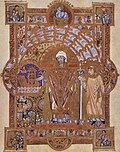 Depiction of the bishop in the Uta Codex , 11th century |
||||
| Sel. Albart | ||||||
| Ratharius | Ratharius is traceable around 730. | |||||
| Wikpert | Wikpert can be detected after 730. | |||||
| 1 | Sel. Gaubald | 739 | 761 | Gaubald was the first bishop after the canonical establishment of the diocese of Regensburg. | ||
| 2 | Sigerich | 762 | 768 | Siegerich is only known by being named. Like his predecessors, he was also head of the St. Emmeram monastery in addition to his position as bishop . Because of his presence at the Synod of Aschheim, historians attribute great political influence to him. | ||
| 3 | Simpert | 768 | 791 | Originally from the Danube region, Simpert was a child of the von Hechlingen family. Like his predecessors, he was also head of the Sankt Emmeram monastery . During his tenure as bishop the dispute over private churches germinated , which could only be ended by Charlemagne, of whose supporters Simpert later became. Even if the chronicler Lorenz Hochwart describes him as a peaceful person in the 16th century , Simpert fell in a battle against the Avars, in which he dropped out of Regensburg together with the king, the bishop of Metz Angilram and the bishop of Freising Atto in August 791 was drawn. | ||
| 4th | Adalwin | 791 | 816 | Adalwin was probably an uncle of the Eichstatt Bishop Altwin . During his time as bishop the first documentary mention of a predecessor building of today's Regensburg Cathedral occurs . The bishop received donations from Charlemagne . | ||
| 5 | Baturich | 817 | 847 | Like some of his predecessors, Baturich came from the noble family of the Hachilinga (see also Hechlingen ). Rabanus Maurus is one of his students. Baturich was appointed arch chaplain by Ludwig the German . Writings from the bishop's possession have been preserved and are now kept in the Bavarian State Library in Munich . | ||
| 6th | Erchanfried | 847 | 864 | Like his predecessors as Abbot Bishop, Erchanfried was also head of the St. Emmeram Monastery. | ||
| 7th | Embricho | 864 | 891 | Embricho, also Ambricho , exchanged possessions with the Eichstätter Bishop Otgar , he gave up Neuburg an der Donau and Egweil . | ||
| 8th | Aspert from Velden | 891 | 893 | Aspert came from Velden and was Arch Chancellor of King Arnulf . Only eight documents have survived from his brief period as bishop. | ||
| 9 | Sel. Tuto | 893 | 930 | In church matters Tuto traveled to Prague, where he was called in by Wenceslaus of Bohemia in an advisory capacity to build a memorial for his grandmother Ludmilla and later the St. Vitus Church at Prague Castle . The construction of Stauf Castle to defend against the Hungarians also fell into his creative period . He was in close contact with the last Carolingians, Arnulf and Ludwig the child . Arnulf donated the Codex aureus to the Sankt Emmeram monastery . Both rulers and Tuto were buried in the monastery. | ||
| 10 | Isangrim | 930 | 941 | The diocese of Regensburg was devastated by the Hungarian invasions, so only a few abbots were present at a provincial synod on January 14, 932 in Regensburg Cathedral . Among the participants were the Eichstatt Bishop Odalfried , Wolfram von Freising and Gerhard von Passau . | ||
| 11 | Sel. Gunther | 942 | 942 | The chronicler and bishop Thietmar von Merseburg described the appointment of Gunther in the form of a legendary narrative, but from which the appointment by the king becomes clear, where the people and clergy could only give their formal approval. | ||
| 12 | Michael | 942 | 972 | Michael was Vicar General of the Bohemian Territories of the Regensburg Diocese based in Prague when he was appointed bishop. Presumably he was there until the murder of Wenceslas of Bohemia . Under Duke Boleslav I , he was invited to the consecration of the St. Vitus Church. Due to the political tension in the wake of the fratricide, he accepted this invitation after a long period of hesitation. Boleslav I gave his son Strachkvas into the care of the St. Emmeram monastery . In Otto the Great's army , Michael took part in the battle in Bohemia. He also took part in the battle against the Hungarians on the Lechfeld . Two important Hungarian leaders were hanged in Regensburg. In the following arguments, the bishop was seriously wounded, of which the chronicler and bishop Thietmar von Merseburg reported in more detail. | ||
| 13 | St. Wolfgang | 972 | 994 | Wolfgang was ordained a priest by Ulrich von Augsburg . His good relationship with the Bohemian Duke Boleslav II favored the establishment of the Prague diocese , in which the Bohemian areas were ceded by the Regensburg diocese. With Ramwod , he allowed the Sankt Emmeram monastery to appoint an independent abbot, thereby ending the previous personal union of the abbot bishops . He helped the monastery to flourish spiritually and culturally, but the economic loss for the bishopric led to ongoing tensions. |
 Depiction of Saint Wolfgang made by Theodoric of Prague , 14th century |
|
| 14th | Gebhard I. | 994 | 1023 | Although Wolfgang had planned his student Tagino as his successor, Otto III determined. Gebhard I. from Andechs-Dießen . Tensions arose with the monastery Sankt Emmeram, which had become independent . Gebhard I. founded the Prüll monastery . | ||
| 15th | Gebhard II. | 1023 | 1036 | Gebhard II was a relative of Ulrich von Zell and Ulrich von Augsburg . One of the few sources about him was court chaplain Wipo . | ||
| 16 | Gebhard III. | 1036 | 1060 | Gebhard III. came from a noble family, he was the son of Adelheid von Metz and thus stepbrother of Konrad II. With his mother he founded the Canons' Monastery of Öhringen , which was recorded in the Öhringer foundation letter . He was involved in several campaigns, especially against Hungary. Because of his rebellion against the emperor, he was briefly imprisoned at Wülflingen Castle. |
 Representation in the Öhringer Obley book around 1420 |
|
| 17th | Otto von Riedenburg | 1061 | 1089 | Otto took part in an armed pilgrimage to Jerusalem. As a supporter of Henry IV , he took part in the clashes with the opposing kings . In the emperor's feud against Ekbert II , the bishop was badly wounded and died shortly afterwards. | ||
| 18th | Gebhard IV of Gosham | 1089 | 1105 | Gebhard IV was probably the son of an excommunicated councilor from Heinrich IV. He was never ordained bishop or recognized by an archbishop or pope during his entire term of office. | ||
| 19th | Hartwig I., from Spanheim | 1105 | 1126 | Hartwig I was involved in founding several monasteries. His older brother was Engelbert . | ||
| 20th | Sel. Konrad I. von Raitenbuch | 1126 | 1132 | Konrad I, also Kuno , was initially abbot of the Siegburg monastery . He gathered well-known scholars around him, including Rupert von Deutz and Norbert von Xanten , during his time as Bishop of Regensburg z. B. Honorius Augustodunensis . He promoted monasteries and carried out reforms there. | ||
| 21st | Heinrich I of Wolfratshausen | 1132 | 1155 | As a result of a feud with Heinrich the Proud , Heinrich I had to cede areas of the bishopric to the right of the Inn , but was able to assert himself in Regensburg. He participated in the Second Crusade , from which he returned early. He was the last bishop to be buried in the monastery of Sankt Emmeram . | ||
| 22nd | Hartwig II., From Spanheim | 1155 | 1164 | Hartwig II was a nephew of the previous bishop Hartwig I from the Spanheimer family . | ||
| 23 | Eberhard the Swabian | 1165 | 1167 | Installed by Emperor Friedrich I , Eberhard accompanied him to Rome to meet the antipope Paschal III. enforce. The victorious army then suffered many victims due to malaria , including Eberhard. | ||
| 24 | Konrad II of Raitenbuch | 1167 | 1185 | Konrad II was the nephew of Konrad I. He took part in the Third Lateran Council in 1179 . | ||
| Gottfried von Spitzenberg | 1185 | 1186 | As Chancellor and Italian legate, Gottfried renounced the Regensburg bishop's seat and a little later became Bishop of Würzburg (1186–1190). He died on the Third Crusade in Antioch . |
 Epitaph of the bishop |
||
| 25th | Conrad III. of Laichling | 1186 | 1204 | Conrad III. took part, like Gottfried von Spitzenberg, in the Third Crusade, from which he returned prematurely. In 1197 he set out again in the crusade of Henry VI. The death of the emperor moved him to repent and he supported Philip of Swabia as a candidate for the throne . Due to the expansion of territory by the Bavarian Duke Ludwig der Kelheimer , not least due to the death of the Steflingers , a feud with Bishop Konrad III broke out, in which the bishopric and its ecclesiastical property were badly devastated. | ||
| 26th | Conrad IV of Frontenhausen | 1204 | 1226 | Konrad IV ended the conflict with Ludwig the Kelheimer not without making concessions. As Chancellor of Philip of Swabia , he negotiated with Pope Innocent III. His concern for his diocese was u. a. by founding monasteries and by using his personal property for the Regensburg Citizens Hospital and as a legacy to the bishopric. | ||
| Gottfrid | 1227 | 1227 | While as his successor, Gottfrid initially rewarded his supporters in the cathedral chapter with church property, this was done through the intervention of Pope Gregory IX. for the installation of Siegfried . | |||
| 27 | Siegfried | 1227 | 1246 | Siegfried's position vis-à-vis the citizens was initially strengthened by nationwide resolutions. His debt situation led to Albert Behaim's investigations and his excommunication. The break with Frederick II , whose chancellor he was, moved the emperor to strengthen Regensburg, which he effectively granted the status of an imperial city . | ||
| 28 | Albert I of Pietengau | 1247 | 1259 | Albert I resided mainly in Donaustauf because of a ban on services . His brother Berthold was Bishop of Passau . Both of them led raids against the Bavarian Duke Otto II. Religious grievances in Regensburg induced Albert I to plot a murder against Konrad IV , who was staying in the city , but this failed and Albert I was forced to flee to Ottokar II in Bohemia. Albert was able to return later. Other reasons eventually led to his resignation from the bishopric and he spent his old age in a monastery. | ||
| 29 | St. Albert II the Great | 1260 | 1262 | Albert II, known as Albertus Magnus , is one of the most important Christian personalities of the Middle Ages. As a scholar, he is considered a doctor of the church and a pioneer of Christian Aristotelianism . Together with Jordan of Saxony, he helped the Dominican order to gain respect. With his appointment as Bishop of Regensburg, Pope Alexander IV defied the cathedral chapter's right to vote in order to give more weight to the idea of the mendicant order in the ranks of bishops and to reorganize the situation in Regensburg. Albert II gave up the office prematurely. He was a contemporary of Berthold of Regensburg . |
 Painting by Joos van Wassenhove , 15th century |
 Seal of the bishop |
| 30th | Leo Thundorfer | 1262 | 1277 | Leo Thundorfer from a Regensburg patrician dynasty took part in armed conflicts in the areas of conflict between Bavaria, Bohemia and Austria. From a political point of view he is one of the peacemakers, he was not only active in peace negotiations but also in the containment of feuds within his own borders. He drove the construction of the Regensburg Cathedral . He tried offensively to bind the monasteries more closely to the bishopric, which led to tensions with the Pope at the monastery of Sankt Emmeram . | ||
| 31 | Heinrich II of Rotteneck | 1277 | 1296 | Heinrich II was the last of the Count von Rotteneck family . He stepped several times between the quarreling Wittelsbach brothers Ludwig II and Heinrich XIII. as a peace broker. He tried to pay off debts, but also continued building work on the cathedral and began building the Bogenberg pilgrimage church . By selling his county, he invested the private assets he had gained in the expansion of castles and palaces. | ||
| 32 | Konrad V. of Luppurg | 1296 | 1313 | Before Konrad V came to Regensburg, he was briefly Elekt von Gurk (1282–1283). As the last of his line, he brought Lupburg castle and rule into the bishopric . The financial situation forced him to pledge the county of Donaustauf , most of which was to remain pledged for centuries. The outbreak of hostility towards Jews met a protective citizenry in Regensburg. | ||
| 33 | Nicholas of Ybbs | 1313 | 1340 | Nikolaus came from a Ybbs patrician family and was in royal service, where he rose to become chancellor. In the controversy for the throne he stood by Ludwig the Bavarian and also took on the devastation of the bishopric by Frederick the Fair . The diocese's first parish register was created around 1326. The murder of Deggendorf Jews is also related to the founding legend of Deggendorfer Gnad . | ||
| Hiltpolt from Haimberg | 1340 | 1340 | In a schismatic election, Heinrich (III.) Von Stein and Friedrich I von Zollern-Nürnberg were elected alongside Hilpolt . Hilpolt immediately renounced the bishop's chair. | |||
| Heinrich (III.) Von Stein | 1340 | 1345 | Counter-Bishop Heinrich III. was elected by a minority of the Regensburg cathedral chapter, which controlled part of the bishopric from 1340 to 1345 , supported by Emperor Ludwig the Bavarian and a large part of the ministry. The uncertain constellation induced both parties to take on debts and to pledge them, which caused massive financial damage to the bishopric. Henry III. renounced the bishop's seat in 1345 and died in August 1346. | |||
| 34 | Friedrich I. Burgrave of Zollern-Nuremberg | 1340 | 1365 | In the dispute with Heinrich III. Friedrich imagined the Regensburg Council and the Pope behind him. When Heinrich III. In 1345 he waived his claims, the emperor failed to appoint a new counter-bishop and accepted Friedrich von Zollern. The Hochstift was sustainably financially weakened by the conflict. In 1349 the plague raged in the diocese, some smaller villages died out completely. |
 Family coat of arms in Scheibler's coat of arms book |
|
| Sedis vacancy | 1365 | 1368 | The administration of the highly indebted bishopric was carried out by the Regensburg cathedral provost Konrad von Haimberg , who was finally elected bishop in 1368. | |||
| 35 | Conrad VI. from Haimberg | 1368 | 1381 | Conrad VI. Due to the overwhelming debt burden, he was forced to submit to the cathedral chapter and receive his salary from it. He was a contemporary of the scholar Konrad von Megenberg , who stayed in Regensburg until the end of his life. | ||
| 36 | Theodoric von Abensberg | 1381 | 1383 | Theodoric from the dynasty of the Counts of Abensberg was able to raise pledges, partly through private assets. | ||
| 37 | Johann I of Moosburg | 1384 | 1409 | Johann I, son of the Bavarian Duke Stephan III. , who could not prevail as Elekt von Freising , was with the help of Pope Urban VI. appointed Bishop of Regensburg. The Pope passed over the election of Paulus Kölner by the cathedral chapter. Johann plunged the bishopric into new debts and pledges. The country pastors, whose livelihoods were almost deprived of their livelihood, suffered from his policies. The city of Regensburg benefited from the bishop's mismanagement, acquiring rights and goods that other cities had to fight hard for. | ||
| 38 | Albert III from Stauffenberg | 1409 | 1421 | Albert III was raised to bishop at a time when popes Alexander V and Gregory XII. faced. He stands for a thrifty court management, for paying off debts and he was also able to win back some areas for the bishopric through purchase. In the feud between the two Bavarian dukes Heinrich von Landshut and Ludwig von Ingolstadt , he held Landshut in the hope of gaining territory for the bishopric through the rule of Hohenburg im Nordgau. | ||
| 39 | Johann II von Streitberg | 1421 | 1428 | Johann II from the von Streitberg family had to defend himself against the attacks of the Hussites during his entire term of office . The defeat in the Battle of Mies meant that the Hussites only penetrated further into the country. The Schönthal Monastery and the Schwarzhofen Monastery were burned down. While the Chancellor reform was willingly accepted in many monasteries, Johann II enforced it by force with the appointment of Abbot Ludwig in the Ensdorf monastery . |
 Family coat of arms in the Ingeram Codex |
|
| Erhard Sattelboger | 1428 | 1428 | A total of three candidates, including Johann Sumpringer , fought to succeed Johann II. While Erhard Sattelboger initially emerged from the election, four members of the cathedral chapter with different interests intervened with Pope Martin V , who quickly decided on a different solution and his supporter Konrad von Soest appointed bishop. |
 Family coat of arms in Siebmacher's coat of arms book |
||
| 40 | Conrad VII of Soest | 1428 | 1437 | Before his appointment as bishop, Conrad VII was in the suite of King Ruprecht and later in the suite of Pope Gregory XII. and then Martin V and was a respected theologian. The Hussites continued to invade the diocese, and the battle of Hiltersried and negotiations did not lead to any relaxation. He was a contemporary of Andreas von Regensburg . | ||
| 41 | Friedrich II of Parsberg | 1437 | 1450 | The election of Frederick II from the von Parsberg family was associated for the first time in Regensburg with an electoral surrender, in which important say and privileges of the canons in connection with the decisions of the bishop were regulated. |
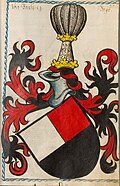 Family coat of arms in Scheibler's coat of arms book |
|
| 42 | Friedrich III. from Plankenfels | 1450 | 1457 | Friedrich III. came from the von Plankenfels family and studied together with his brother Ulrich von Plankenfels , who was appointed bishop of Chiemsee in 1453 . The election surrender was further expanded. The conflict with the Hussites had calmed down, but found a subtle continuation through the threats and deportation of clergymen, in which German nobles were involved. |
 Family coat of arms in Scheibler's coat of arms book |
|
| 43 | Ruprecht I of Pfalz-Mosbach | 1457 | 1465 | Ruprecht I, the son of Count Palatine Otto I and thus the grandson of King Ruprecht , appeared suitable, due to his family circumstances, to put a stop to the Hussites and robber aristocrats. A synod that was held dealt with specific grievances, so beneficiary owners were obliged to pay their deputies better. The bishop died at the young age of 32. |
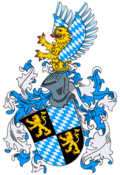 Family coat of arms of the Wittelsbach family |
|
| 44 | Heinrich IV of Absberg | 1465 | 1492 | Heinrich IV. Was harassed by the Bavarian Duke Albrecht IV. In Regensburg : Albrecht IV. Released old pledges and, with increasing influence, questioned the status of an imperial city . In 1492 he had to go through the intervention of Emperor Friedrich III. withdraw. Heinrich IV fought against the false teachings of Lewin and Janko von Wirsberg . The printing press allowed in Regensburg for the first time the production of various religious writings. |
 Representation of the bishop |
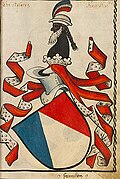 Family coat of arms in Scheibler's coat of arms book |
| 45 | Ruprecht II of Pfalz-Simmern | 1492 | 1507 | Ruprecht II suffered from a serious illness, probably yaws , which severely impaired his administration and of the consequences of which he eventually died. The diocese was devastated in the Landshut War of Succession . Inquisitor Heinrich Kramer intervened in the pursuit of witches and wizards in the Abensberg area . |
 Family coat of arms of the Wittelsbach family, Pfalz-Simmern line |
|
| 46 | Johann III. from the Palatinate | 1507 | 1538 | Johann III. As the son of Elector Philip, he came from highly influential circles, his brothers were electors or also bishops. The times were marked by serious unrest: In Regensburg there was an uprising from 1511 to 1513, especially against the emperor's officials. After the death of Emperor Maximilian I , open hostilities against the Regensburg Jews broke out in 1519 , which led to the destruction of their synagogue and the expulsion of the Jewish population from the city. The "re" Baptist Balthasar Hubmaier preached in the city. In the course of the Reformation , the diocese lost the dean's office in Wunsiedel , and the sovereign Georg the Pious cracked down on disliked clergy there. |
 Family coat of arms of the Wittelsbach family |
|
| 47 | Pankraz of Sinzenhofen | 1538 | 1548 | Pankraz suffered from considerable mental and physical ailments, and he had nothing to counter the rapid spread of the Reformation in his diocese. Elsewhere, however, counter-Reformation forces formed in the Council of Trent and in the ranks of the Jesuit order . |
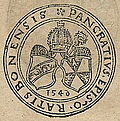 Episcopal coat of arms on a coin from 1546 |
|
| 48 | Georg Marschalk von Pappenheim | 1548 | 1563 | The von Pappenheim family produced high ecclesiastical dignitaries at that time, in addition to Georg also the Eichstatt Bishop Christoph and the humanist Matthäus . The Counter-Reformation reached the diocese, and the Peace of Augsburg, both imperial and religious, eased the tensions raised. Scholars such as Nicolaus Gallus and Justus Jonas the Elder contributed to the confessionalization of Protestantism in Regensburg. |
 Family coat of arms in Scheibler's coat of arms book |
|
| 49 | Veit von Fraunberg | 1563 | 1567 | Veit from the Fraunberg family saw his position as bishop vis-à-vis the cathedral chapter strengthened in the implementation of the resolutions of the Council of Trent . He took part in the Diet of Augsburg in 1566 and died a year later at Castle Wörth on the Danube . | ||
| 50 | David Kölderer from Burgstall | 1567 | 1579 | David tried to implement the decisions of the Council of Trent . This included the establishment of seminars for priests to ensure professional training of priests and visits to monasteries, with Pope Gregory XIII. the sovereign Albrecht V was able to win over the reform efforts. | ||
| 51 | Philipp Wilhelm Duke of Bavaria | 1579 | 1598 | The election of 1579 fell on Philipp, the three-year-old son of the Bavarian Duke Wilhelm V. The intention with this election was to bind the heavily indebted bishopric closely to the Bavarian duchy and to be able to assert itself against the Protestant Regensburg. The administration of the bishopric and the ecclesiastical tasks performed various deputies, the Apostolic Nuncio Felizian Ninguarda and Jakob Miller are particularly noteworthy . Philip was promoted to cardinal at the age of 20, but he died two years later. |
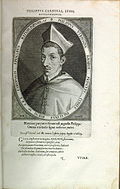 Representation around 1600 |
 Family coat of arms of the Wittelsbach family |
| 52 | Sigmund Friedrich von Fugger | 1598 | 1600 | Sigmund from the Fugger family continued the work of his predecessors in his short time as bishop in the implementation of the council and the discharge of the debt burden. |
 Colored engraving from 1618 |
 Family coat of arms in Siebmacher's coat of arms book |
| 53 | Wolfgang II von Hausen | 1600 | 1613 | Wolfgang from the Swabian noble family von Hausen was already prince provost of Ellwangen (1584-1603) before his election as bishop and was responsible for the first witch trials there . As a bishop he was in the favor of the Bavarian Duke Maximilian I and also campaigned for his chairmanship in the Catholic League . |
 Representation of the bishop |
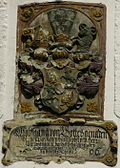 Relief of the coat of arms in Regensburg |
| 54 | Albert IV of Toerring | 1613 | 1649 | Albert IV from the Toerring family profited from the re-catholicization that sovereign Wolfgang Wilhelm carried out with increasing means of coercion in the Upper Palatinate . In the Thirty Years' War the Catholic League was defeated by the Swedish King Gustav Adolf . In 1633 the bishopric was stormed under Bernhard von Sachsen-Weimar , Albert IV initially fled and was later imprisoned in Würzburg. Educated Austrian exiles found refuge in Regensburg. In 1644, the bones of the martyr and Saint Justin were transferred to the Regensburg Cathedral as catacomb saints. |
 Family coat of arms in Scheibler's coat of arms book |
|
| 55 | Franz Wilhelm Count of Wartenberg | 1649 | 1661 | Franz Wilhelm came from the morganatic marriage of the son Ferdinand of the Bavarian Duke Albrecht V and Maria von Pettenbeck. In his extensive spiritual training he also went through the Collegium Germanicum et Hungaricum . From 1625 he was bishop of Osnabrück and briefly also bishop of Verden (1630-1631) and bishop of Minden (1631-1648). In 1649 he was appointed bishop of Regensburg. Due to other high offices and his obligations for the Diocese of Osnabrück , he only stayed in Regensburg for a while. In terms of the accumulation of offices , this was not in line with the demands of the Council of Trent, on the other hand he was a person of supraregional importance and an important negotiator of the Peace of Westphalia . In 1649 and 1660 Franz Wilhelm held the last two synods for the diocese of Regensburg for centuries. |
 17th century painting |
|
| 56 | Johann Georg Graf von Herberstein | 1662 | 1663 | Johann Georg died just one year after his appointment without having received the ordination. | ||
| 57 | Adam Lorenz Count von Törring | 1663 | 1666 | Adam Lorenz was a nephew of Bishop Albert IV from the Toerring house . In the only three years as bishop Adam Lorenz lived on the family seat in Pertenstein and, like his ancestors, was buried in Baumburg Monastery, his heart in Regensburg Cathedral . |
 Family coat of arms in Scheibler's coat of arms book |
|
| 58 | Guidobald Count of Thun | 1666 | 1668 | Guidobald was Archbishop of Salzburg (1654–1668) and cardinal. In his short time as Bishop of Regensburg he renounced his income as Bishop of Regensburg to pay off the debts of the bishopric. |
 contemporary engraving |
 Family coat of arms |
| 59 | Albrecht Sigismund Duke of Bavaria | 1668 | 1685 | Beginning with Albrecht Sigismund, the Bavarian Wittelsbachers also permanently consolidated their ecclesiastical influence on their duchies. Albrecht Sigismund was also already Bishop of Freising (1652–1685) when he was elected Bishop of Regensburg. Marco d'Aviano's visit to the city was an outstanding event ; his miracles were highly controversial. Albrecht Sigismund was buried in the Freising Cathedral . |
 Painting by Franz Joseph Lederer |
 Family coat of arms of the Wittelsbach family |
| 60 | Joseph Clemens Duke of Bavaria | 1685 | 1716 | Joseph Clemens succeeded his cousin Albrecht Sigismund both as Bishop of Regensburg and as Bishop of Freising (1685–1694). Pope Innocent XI. put him through as an absolutist elector and archbishop of Cologne (1688–1723), which contributed to the Palatinate War of Succession . Due to the accumulation of offices , Joseph Clemens had to do without Freising and Regensburg in 1694. In Regensburg, however, he was re-elected by the cathedral chapter, and they continued to seek proximity to the financially strong Bavarian neighbors from the Wittelsbach family. His relationship with the Sun King Louis XIV forced him into French exile, from which he returned in 1715 after the War of the Spanish Succession . He was also Bishop of Liège (1694–1723), Bishop of Hildesheim (1702–1723) and Prince Provost of Berchtesgaden (1688–1723). He had three children. |
 Painting by Josef Vivien |
 Family coat of arms of the Wittelsbach family |
| 61 | Clemens August Duke of Bavaria | 1716 | 1719 | Clemens August distinguishes himself among the Regensburg bishops by the fact that he was a layman , i.e. not ordained a priest. Administration in Regensburg was taken over by the later Auxiliary Bishop Gottfried Langwerth von Simmern for Clemens August, who was still a minor when he was elected . In 1719, Clemens August exchanged the bishop's seat in Regensburg for the bishopric of Münster (1719–1761) and Paderborn (1719–1761) as well as the lucrative office of canon in Cologne with the prospect of the office of archbishop of Cologne , which he obtained in 1723 and with it the rank of elector. He was another Wittelsbacher who united many honors in his hand, because he was also Bishop of Hildesheim (1724–1761) and Osnabrück (1728–1761) and Grand Master of the Teutonic Order (1732–1761). This gave him several votes in the Reichstag. Today Clemens August is best known for his services as a builder, patron and art collector. |
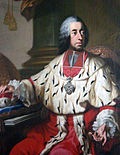 Painting by George Desmarées |
 Depiction of the coat of arms in Weingarten |
| 62 | Johann Theodor Duke of Bavaria | 1719 | 1763 | While his brother and predecessor Clemens August resigned due to other offices, Johann Theodor took over Regensburg and Freising (1727–1763), later he received the diocese of Liège (1744–1763). In the following generation, the Wittelsbachers were no longer able to fill all spiritual offices due to the lack of male descendants. |
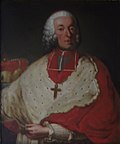 Painting by Franz Joseph Lederer |
 Family coat of arms of the Wittelsbach family |
| 63 | Clemens Wenzeslaus Duke of Saxony | 1763 | 1769 | As the son of the Saxon Elector and King of Poland August III. followed Clemens Wenzelaus as bishop of Regensburg and Freising (1763–1768). In addition to other ecclesiastical dignities and possessions, he rose to Archbishop of Trier (1768–1803) and Bishop of Augsburg (1768–1803 / 12), in favor of which he gave up the Regensburg bishopric. |
 painting |
 Depiction of the coat of arms in Niederselters |
| 64 | Anton Ignaz Count von Fugger | 1769 | 1787 | As Prince Provost of Ellwangen (1756–1787) and with the encouragement of the Bavarian Wittelsbachers, Anton Ignaz became Bishop of Regensburg. He is considered to be a learned man and lived in pious seclusion. He managed to redeem the rule of Donaustauf , which had been pledged for centuries . |
 painting |
|
| 65 | Max Prokop Count von Törring | 1787 | 1789 | Maximilian Prokop became Bishop of Regensburg in 1787 and a year later Bishop of Freising (1788–1789). It stands for an internalized, enlightened faith that turns away from baroque popular piety. He spoke out against overly rambling and exaggeratedly staged Passion plays , which were very popular at the time. |
 painting |
 Family coat of arms in Scheibler's coat of arms book |
| 66 | Joseph Konrad Freiherr von Schroffenberg | 1790 | 1803 | Joseph Konrad was initially Prince Provost of Berchtesgaden (1780–1803) and accepted the episcopal dignity in Regensburg and Freising (1789–1802 / 1803). As a result of secularization , Joseph Konrad lost his lands. In the Reichsdeputationshauptschluss the Hochstift Regensburg was transformed into the Principality of Regensburg . |
 Painting around 1790 |
 Prince-Bishop's coat of arms as a watercolor hand drawing |
| 67 | Karl Theodor Freiherr von Dalberg | 1802 | 1817 | Karl Theodor was Bishop of Konstanz (1799–1802) and Worms (1802–1803), as well as Archbishop of Mainz (1802–1803). As a result of the secularization and the Reichsdeputationshauptschluss , he was given the newly formed principalities of Regensburg and Aschaffenburg as Imperial Arch Chancellor , which a little later were raised together to the electorate. As Archbishop of Regensburg and the title of Prince Primate , he tried to strengthen the Catholic influence. He promoted education and was in contact with the Weimar Court of Muses . With the fall of Napoleon , the political innovations did not last. |
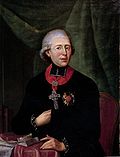 painting |
 Family coat of arms in Scheibler's coat of arms book Fief seal as prince primate  |
| Sedis vacancy | 1817 | 1821 | After Dalberg's death and as a result of the Bavarian Concordat of 1817, Johann Nepomuk von Wolf was initially appointed administrator and in 1821 was appointed bishop. | |||
| 68 | Johann Nepomuk von Wolf | 1821 | 1829 | Johann Nepomuk Wolf was born in 1743 as the son of a civil servant in Öttingen im Ries , grew up in Troppau and Olmütz , where he also attended school and in 1759 came to the Collegium Germanicum in Rome. In 1762 he acquired the theological doctorate there, in 1763 he returned home, in 1766 he was ordained a priest. In 1776 Wolf advanced to the position of clergyman in the Principality of Regensburg. In 1789 he was appointed auxiliary bishop in Freising and in 1802 as cathedral dean and auxiliary bishop in Regensburg. Due to the circumstances of the time, the vacant bishopric seats in Bavaria could only be filled again after the Concordat of 1817 . After the death of the last Prince-Bishop Karl Theodor von Dalberg (May 7, 1817), Johann Nepomuk Wolf initially served as Apostolic Administrator ; on September 13, 1821 he was appointed bishop of Regensburg. Since he was already 78 years old at that time and his health was in poor health, he received an auxiliary bishop and coadjutor in his later successor Johann Michael Sailer in 1822. |
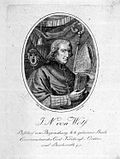 Engraving depicting the bishop |
|
| 69 | Johann Michael von Sailer | 1829 | 1832 | Johann Michael Sailer was born the son of a shoemaker in Aresing near Schrobenhausen . After studying (1772–1777) and ordination (1775), he worked as a theology professor in Ingolstadt (1777–1781), Dillingen (1784–1794) and Landshut (1800–1821). In 1821 he became cathedral capitular in Regensburg, auxiliary bishop and coadjutor with the right of succession; only bishop in 1829. Although he only served as senior shepherd for three years, he is the most famous of the Regensburg bishops of the 19th century. Sailer was an important theologian, writer and cleric with far-reaching influence, especially as an educator and advisor to King Ludwig I , who praised him as the "Apostle of Bavaria". He converted Melchior von Diepenbrock , the later cardinal, to the faith and Pope John Paul II described Sailer as "a doctor of the church not only from Germany, but even from all of Europe." |
 painting |
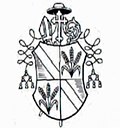 Episcopal coat of arms |
| Georg Michael Wittmann | 1832 | 1833 | Georg Michael Wittmann was born the son of a hammer estate owner in Finkenhammer near Pleystein . After studying at Heidelberg University , he was ordained priest in 1782 in Regensburg ; In 1788 the clergyman was called to the episcopal city of Regensburg . Wittmann trained priests there for 45 years as sub- rain and from 1802 as rain for the seminary . He belonged to Johann Michael Sailer's environment and had his special confidence. From 1804 to 1829 Wittmann was also cathedral pastor of Regensburg, from 1821 cathedral capitular , from 1829 cathedral provost and auxiliary bishop and from 1830 also vicar general . Wittmann was Sailer's closest colleague and he wanted Wittmann to be his successor. King Ludwig I complied with this wish after Sailer's death in 1832. However, the new bishop died before the papal confirmation was received, in the name of holiness. His goodness and piety were famous; in the meantime the process of beatification was initiated. |
 painting |
||
| 70 | Franz Xaver von Schwäbl | 1833 | 1841 | Franz Xaver Schwäbl was born as the 21st child of a baker in Reisbach , Lower Bavaria . In 1798 he entered the Institute of the Bartholomeans in Ingolstadt . He studied there and in Landshut and was one of Johann Michael Sailer's students , who had a decisive influence on his theological thinking and his ecclesiastical attitude. In 1801 Schwäbl was ordained a priest in Regensburg. Initially active in pastoral care, Crown Prince Ludwig met him and in 1823 ensured his appointment as canon in the Munich Metropolitan Chapter. Archbishop Lothar Anselm von Gebsattel entrusted him with the supervision of the training of priests in the Archdiocese of Munich-Freising. After the almost simultaneous death of Bishop Sailer and Bishop Wittmann, King Ludwig I of Bavaria appointed him the new Bishop of Regensburg in 1833. Franz Xaver Schwäbl endeavored to renew pastoral care in the spirit of Bishop Sailer, and the training of priests was particularly important to him. He introduced his own catechism and enlivened monastic and religious life in his diocese. The regotization of the cathedral in Regensburg (1835–1839) also fell during his term of office. |
 Engraving from 1835 |
|
| 71 | Valentin von Riedel | 1842 | 1857 | Valentin Riedel came from a poor background and was born in Lamerdingen , Bavarian Swabia, in 1802 . Patrons financed his studies, he was ordained a priest on March 28, 1825, and in the same year he was employed as a preacher at Sankt Martin in Landshut , then at Sankt Michael in Munich . In 1838 he was appointed director of the seminary in Freising and professor of moral and pastoral theology at the local Lyceum. King Ludwig I appointed Valentin Riedel as bishop of Regensburg on the recommendation of Minister Karl von Abel ; on March 13, 1842 he was consecrated. As a bishop, he was particularly concerned about the promotion and training of the next generation of priests, for which purpose he founded the Episcopal Boys' College in Metten in 1844. The chief shepherd sustainably promoted the monasteries and orders, church music and ecclesiastical art for the care of which he founded the church art association of the diocese in 1854 together with Abbot Gregor Scherr von Metten. Valentin Riedel supported the Regensburg church musician Carl Proske in his efforts to create a dignified form of the liturgy and in 1857 issued appropriate musical texts for his diocese. Bishop Riedel died in 1857 after a long illness. | ||
| 72 | Ignatius of Senestrey | 1858 | 1906 | He was born in 1818 as the child of Georg Ignaz Senestrey and Anna Maria geb. Gmeiner was born in Bärnau , Upper Palatinate. In Munich he passed his Abitur in 1836 and the uncle General Vicar Pantaleon of Senestrey there promoted his desire to become a priest. The young man studied at the Germanicum in Rome and was ordained a priest there on March 19, 1842. In 1843 he officiated as prefect at the Eichstätt seminary and as a lecturer at the local lyceum. He then became pastor of Kühbach (Diocese of Augsburg), on July 1, 1853, cathedral capitular in Eichstätt. In the winter of 1856/57 he undertook a trip to Rome with King Maximilian II , where Pope Pius IX. received in private audience. He appointed Ignatius of Senestrey, on a royal proposal, on January 27, 1858, bishop of Regensburg. The new bishop turned out to be a zealous shepherd of his diocese, which he visited almost completely in his first year in office. He set up two seminaries, founded several nunneries and had the west facade and the two unfinished towers of Regensburg Cathedral completed. Ignatius of Senestrey attended the First Vatican Council , where he appeared as a staunch advocate of the dogma of papal infallibility . As a result, he created many enemies in his homeland, and the image of the bishop is still clouded by the disputes of that time. In the last decade of the 19th century he was awarded the honorary title of Archbishop and the Pallium. Senestrey died in 1906, at the age of 88. |
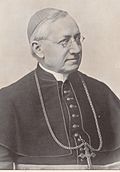 Photography from 1900 |
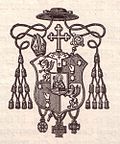 Archbishop's coat of arms |
| 73 | Antonius von Henle | 1906 | 1927 | Franz Anton von Henle was born as the son of the brewer and innkeeper Anton Henle and his wife and Maria Anna, nee. Schmid was born in Weißenhorn . In Dillingen he attended grammar school and completed his philosophical-theological studies, whereupon he was ordained priest on November 23, 1873 in Augsburg . In 1884 Henle received his doctorate in theology in Munich ; after further studies, he completed his habilitation in February 1887 and became a private lecturer at the University of Munich , where he taught Hebrew. In 1890, Franz Anton Henle was appointed Cathedral Capitular in his home diocese of Augsburg; shortly afterwards he was promoted to vicar general there. When the Passau Bishop Michael von Rampf died, Franz Anton Henle was elected as his successor on April 3, 1901, the papal preconization took place on April 18, 1901 his episcopal ordination by the Munich Archbishop Franz Joseph von Stein . In Passau , Henle immediately began to expand the seminary and published a new hymn book; In 1902 he received the personal title of nobility and membership in the Imperial Council of the Crown of Bavaria. After the death of Regensburg Bishop Ignatius von Senestrey , Franz Anton von Henle was appointed his successor on October 18, 1906. Henle led his new diocese for over 21 years with great zeal and outstanding expertise. On October 11, 1927, he solemnly opened the long-awaited diocesan synod of his diocese, but died unexpectedly of cardiac death the following night. |

|
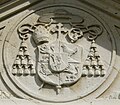 Episcopal coat of arms, accidentally depicted with archbishop's number of tassels |
| 74 | Michael Buchberger | 1928 | 1961 | Michael Buchberger edited several comprehensive church encyclopedias, including a. the lexicon for theology and the church . His stance of “Christian” anti-Semitism , which he adopted in his works published during the National Socialist era , received criticism . In the post-war period he was involved in the reconstruction by building numerous new churches and establishing a wide range of charitable institutions. For his services, Pope Pius XII awarded him . 1950 the personal title of Archbishop and he was awarded the Federal Cross of Merit in 1953 . |

|
 Archbishop's coat of arms |
| 75 | Rudolf I. Graber | 1962 | 1982 | Rudolf Graber was involved as a priest in the Union of New Germany . Before his appointment as bishop he taught a. a. as a professor at the Catholic University of Eichstätt . |
Episcopal coat of arms |
|
| 76 | Manfred Mueller | 1982 | 2002 | Manfred Müller was auxiliary bishop in Augsburg from 1972 . Various teaching activities led him to advisory bodies on the organization of Catholic teaching in Bavaria. After the collapse of real socialism , he got involved in the dioceses of Prague and Pilsen in building new structures and institutions. He died on May 20, 2015 at the age of 88. |
 Episcopal coat of arms |
|
| 77 | Gerhard Ludwig Müller | 2002 | 2012 | Gerhard Ludwig Müller was appointed Bishop of Regensburg by Pope John Paul II in 2002 and consecrated by Archbishop Friedrich Cardinal Wetter . In the German Bishops' Conference , Müller is chairman of the Ecumenical Commission. Since 2009 he has been a member of the Pontifical Council for Culture . On July 2, 2012, he was received by Pope Benedict XVI. Appointed to the Roman Curia and appointed Prefect of the Congregation for the Doctrine of the Faith and President of the Pontifical Ecclesia Dei Commission , the Pontifical Biblical Commission and the International Theological Commission. His five-year term as head of the Roman Congregation for the Doctrine of the Faith was not extended by Pope Francis in 2017. |

|
 Episcopal coat of arms |
| 78 | Rudolf II. Voderholzer | 2013 | On December 6, 2012, Pope Benedict XVI appointed him . to the bishop of Regensburg.
The episcopal ordination by Reinhard Cardinal Marx took place on January 26, 2013 in Regensburg Cathedral ; Co- consecrators were Archbishop Gerhard Ludwig Müller and František Radkovský , Bishop of Pilsen . His episcopal motto is Christ in vobis spes gloriae ("Christ is among you - the hope of glory"). Voderholzer is considered an expert on Henri de Lubac . Through his translation of “ L'Ecriture dans la Tradition ” (German: “The Holy Scriptures in the Tradition of the Church”) and other essays, he has acquired essential parts of de Lubac's four-volume work “ Exégèse médiévale ” (German: “Exegese des Mittelalters”) ) in German with the title “Typologie. Allegory. Spiritual sense. Studies on the History of Christian Interpretation of Scripture ”(Freiburg, 2nd edition 2007). He is the founding director of the “ Institute Pope Benedict XVI. “In Regensburg and editor of the collected theological writings of Pope Benedict XVI. Since October 30, 2010 Voderholzer has been a full member of the Sudeten German Academy of Sciences and Arts (humanities class). |

|
 Episcopal coat of arms |
literature
- Michael Buchberger (Ed.): 1200 years of the diocese of Regensburg . Regensburg 1939.
- Karl Hausberger : The diocese of Regensburg. His story . Regensburg 2004. pp. 216f.
- Karl Hausberger: History of the diocese of Regensburg . Volume 2: From the Baroque to the Present . Regensburg 1989. p. 261.
- Josef Staber: Church history of the diocese of Regensburg . Regensburg 1966.
Individual evidence
- ↑ The Duchy of Lower Bavaria - Straubing in the Hussite Wars (pp. 104,145,149) ; PDF file 2.67 MB
- ↑ a b Photos of beautiful old coats of arms: Regensburg, Bischofshof , accessed on November 26, 2018.
- ↑ Thun-Hohenstein, Guidobald Graf in the Austria-Forum portal, accessed on November 26, 2018.
- ↑ Wolfgang Seegrün : Clemens August von Bayern: Priest, Bishop, Politician . In: Niedersächsisches Jahrbuch für Landesgeschichte , vol. 60 (1988), pp. 15–32, here p. 17.
- ^ Rinuncia di Prefetto della Congregazione per la Dottrina della Fede e di Presidente della Pontificia Commissione "Ecclesia Dei", della Pontificia Commissione Biblica e della Commissione Teologica Internazionale , in: Press Office of the Holy See: Daily Bulletin of July 2, 2012.
- ^ Pope Francis leaves Cardinal Müller as head of the Congregation for the Doctrine of the Faith . In: Süddeutsche Zeitung , June 30, 2017. Accessed July 1, 2017.
- ^ Nomina del Vescovo di Regensburg (Germania) , in: Press Office of the Holy See: Daily Bulletin of December 6, 2012.
- ↑ "Benedict Institute" , Vatican Radio , September 13, 2008
Remarks
- ↑ a b c d e f Wandering bishop, the counting of the bishopric only begins with the establishment of the diocese
- ↑ a b c d e f is not counted in the official episcopal series
Web links
- The series of bishops on the official website of the diocese
- The series of bishops in the article Regensburg . In: Pierer's Universal Lexicon . tape 13 , p. 925-926 ( zeno.org ).

